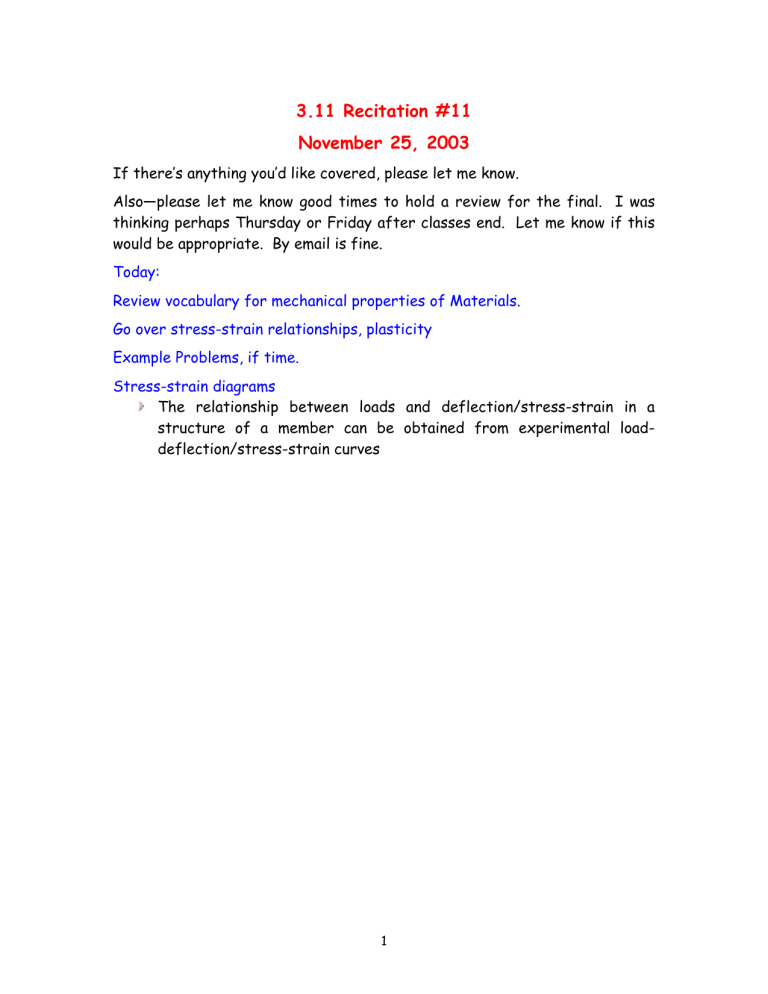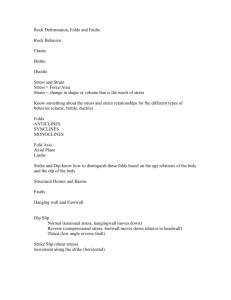3.11 Recitation #11 November 25, 2003

3.11 Recitation #11
November 25, 2003
If there’s anything you’d like covered, please let me know.
Also—please let me know good times to hold a review for the final. I was thinking perhaps Thursday or Friday after classes end. Let me know if this would be appropriate. By email is fine.
Today:
Review vocabulary for mechanical properties of Materials.
Go over stress-strain relationships, plasticity
Example Problems, if time.
Stress-strain diagrams
The relationship between loads and deflection/stress-strain in a structure of a member can be obtained from experimental loaddeflection/stress-strain curves
1
dL/2
P
P/2 P/2
P
L
δ
Bending test
P
P
Shear Test
T
T dL/2
P
Tension test
Torsion test
P
Compression test
The most common tests are tension test for ductile materials (steel)
& compression test for brittle materials (concrete)
2
Tension Test
σ
Yield Stress σ y
:
Stress at which a slight increase in stress will result in appreciably increas in strain without increase in stress
Elastic Limit :
The upper stress level at which the material behaves elastically
Proportional Limit
: The upper stress limit that strain
σ varies linearly with stress. Material follows Hooke's Law
PL
σ ′ f
True Stress-strain using actual area to calculate
Ultimate stress σ u
Failure stress σ f
A
Yield strain ε
B'
Stress-strain using original area to calculate
C y
10 - 40 times elastic strain
:
C'
Necking
ε
Elastic Yielding
Strain Hardening :
Material can resist more load increase
Necking
Elastic Behaviour : Ma terial will return to its orginal shape if material is loaded and unloaded within this range
Plastic Behaviour : Material will deform permanently and will NOT retur n to its orginal shape upon unloading. The deformation that occurs is called plastic deformation
Stress-strain diagram for ductile materials
Hooke’s Law :
σ = E ε
E is the modulus of elasticity
E steel
= 200 GPa
E concrete
= 29 GPa (21 – 29 GPa)
3
Ductile Materials
Materials that can be subjected to large strains before rupture
Have high percent elongation
Percent elongation =
Have high percent reduction in area
Percent reduction in area =
f
L o o
× 100
−
A o f
× 100
Have capacity to absorb energy
If structure made of ductile materials is overloaded, it will present large deformation before failing
Some ductile materials do not exhibit a well-defined yield point, we will use offset method to define a yield strength
Some ductile materials do not have linear relationship between stress
σ σ
σ y
σ = f
ε ε
0.002 or 0.2% offset
Elastic-plastic Materials
Stress-strain for structural steel will consist of elastic and perfectly plastic region. We call this kind of material elastoplastic material
Analysis of structures on the basis of elastoplastic diagram is called elastoplastic analysis or plastic analysis
4
σ
Bilinear stress-strain diagram having different slopes is sometimes used to approximate the general nonlinear diagrams. This will include the strain hardening.
σ σ y
Perfectly plastic Strai n har denin g
Nonlinear
Linearly elastic
Linearly elastic
ε ε
ε y
Brittle Materials
Materials that do not exhibit yielding before failure
Some materials will show both ductile and brittle behaviours, e.g. steel with high carbon content will demonstrate brittle behaviours while steel with low carbon content will be ductile or steel subjects to low temperature will be brittle while those in the high temperature environment will be ductile
Creep
Deformation which increases with time under constant load (examples: rubber band; concrete bridge deck: sagging between supports due to self weight therefore the deck is constructed with an upward camber )
δ
δ o t o t
δ
P
In several situations, creep will associate with high temperature
If creep becomes important, creep strength will be used in design
5
Relaxation
Loss of stress with time under constant strain
Another manifestation of creep
σ o
σ
Prestressed wire
Creep strength t
Cyclic loading and fatigue
Fracture after many cycles of loading
If material is loaded into the plastic region, upon unloading elastic strain will be recovered but plastic strain remains
σ Elastic region
Loading
Unloading
ε
Permanent set
Elastic recovery
6
Strain energy
Energy stored internally throughout the volume of a material which is deformed by an external load k x
F
F
F o
Work x x o x . The relationship x is
F = kx amount of x o
, the work done is the average force magnitude times the displacement, i.e.
W
1
2
F o x o
From the conservation of energy, this work done must be equivalent to the internal work or strain energy stored within the spring when it is deformed
7
dz
σ
If an infinitesimal element of elastic material is subjected to a normal stress σ , then tensile force on the element will be dF = σ dxdy
The change in its length is ε dz dy dx
σ
The work done, which equals to the strain energy stored in the element, is dU =
1
2
( σ dxdy
)( ε dz
) or dU =
1
2
σε dV
The total strain energy stored in a material will be
U =
V
∫
σε d V
The strain energy per unit volume or the strain energy density is u = dU dV
=
1
2
σε
If the material is linear elastic ( σ = E ε energy density will be
, Hooke’s Law holds), the strain u =
1
2
σ =
1 σ 2
2 E
σ
σ
PL
If the stress σ reaches the proportional limit, the strain energy density is called the modulus of resilience u r u r u r
=
1
2 PL
ε
PL
ε
8
σ u t
Two Example Problems:
ε
The total strain energy density which stored in the material just before it fails is called the modulus of toughness u t
9
Answer to 1.
10
Answer to 2.
11
More on crazing and shear deformations and zones next time. (Phenomena in amorphous polymers, as discussed yesterday)
12




